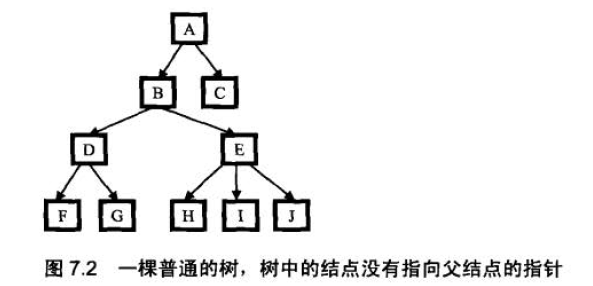【劍指Offer學習】【面試題50:樹中兩個結點的最低公共祖先】
阿新 • • 發佈:2019-01-01
題目:求樹中兩個結點的最低公共祖先,此樹不是二叉樹,並且沒有指向父節點的指標。
樹的結點定義
private static class TreeNode {
int val;
List<TreeNode> children = new LinkedList<>();
public TreeNode() {
}
public TreeNode(int val) {
this.val = val;
}
@Override
public String toString() {
return 題目解析
假設還是輸入結點F和H .
我們首先得到一條從根結點到樹中某一結點的路徑,這就要求在遍歷的時候,有一個輔助記憶體來儲存路徑.比如我們用前序遍歷的方法來得到從根結點到H 的路徑的過程是這樣的:( 1 )遍歷到A,把A 存放到路徑中去,路徑中只有一個結點A; ( 2 )遍歷到B,把B 存到路徑中去,此時路徑為A->B; ( 3 )遍歷到D,把D 存放到路徑中去,此,時路徑為A->B->D; ( 4 ) :遍歷到F,把F 存放到路徑中去,此時路徑為A->B->D->F;( 5) F 已經沒有子結點了,因此這條路徑不可能到這結點H. 把F 從路徑中刪除,變成A->B->D; ( 6 )遍歷G. 和結點F 一樣,這條路徑也不能到達H. 邊歷完G 之後,路徑仍然是A->B->D; ( 7 )由於D 的所有子結點都遍歷過了,不可能到這結點H,因此D 不在從A 到H 的路徑中,把D 從路徑中刪除,變成A->B; ( 8 )遙歷E,把E 加入到路徑中,此時路徑變成A->B->E, ( 9 )遍歷H,已經到達目標給點, A->B->E 就是從根結點開始到達H 必須經過的路徑。
同樣,我們也可以得到從根結點開始到達F 必須經過的路徑是A->B功。接著,我們求出這兩個路徑的最後公共結點,也就是B. B這個結點也是F 和H 的最低公共祖先.
為了得到從根結點開始到輸入的兩個結點的兩條路徑,需要追歷兩次樹,每邊歷一次的時間複雜度是O(n).得到的兩條路徑的長度在最差情況時是0(時,通常情況丁兩條路徑的長度是O(logn).
注意:可以在只遍歷樹一次就找到兩個結點的路徑,這部分留給讀者自己去完成。
程式碼實現
import java.util.Iterator;
import java.util.LinkedList;
import java.util.List;
public class Test50 {
/**
* 樹的結點定義
*/
private static class TreeNode {
int val;
List<TreeNode> children = new LinkedList<>();
public 

